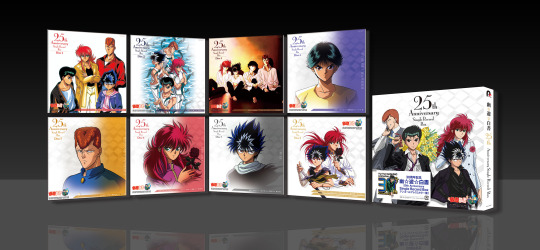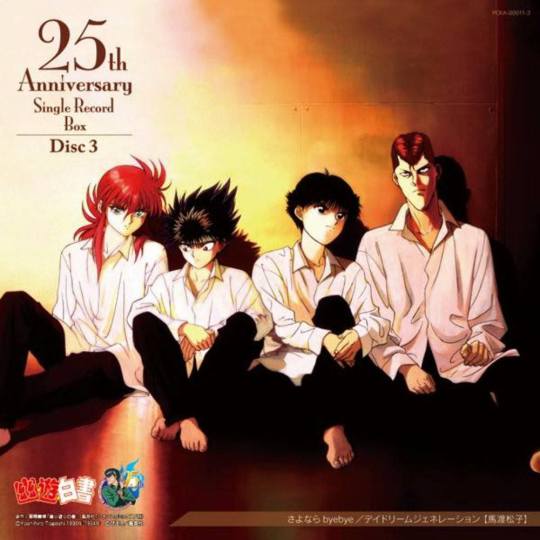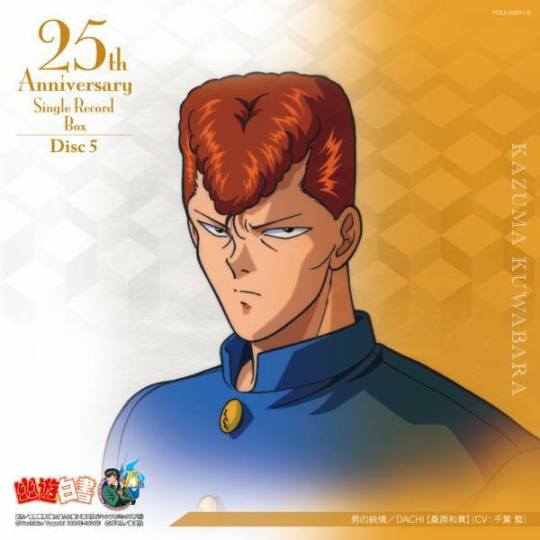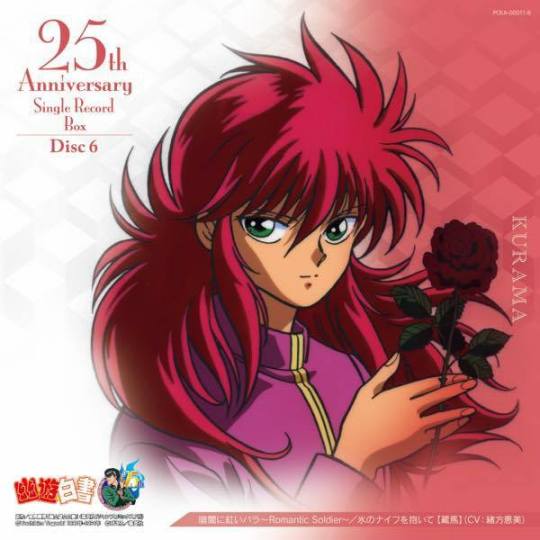#Yu Yu Hakusho - Ending 4 | The Sun Will Shine Again
Video
youtube
Yu Yu Hakusho - Ending 4 | The Sun Will Shine Again
0 notes
Text


30th Anniversary "Yu Yu Hakusho 25th Anniversary Single Record Box" Encore Press [Color Record]
To celebrate the 30th anniversary of the "Yu Yu Hakusho" anime series, the very popular and sold out limited edition of the "Yu Yu Hakusho 25th Anniversary Single Record Box", released in 2017, will be re-released in response to the fans requests.
The design remains the same, but the black vinyl from 2017 have been changed to colored vinyl. The box contains eight 7-inch colored singles with 16 songs in total, such as anime theme songs and character songs.

In addition, the duet tracks of Kurama and Hiei (WILD WIND), and Yusuke and Keiko (Omoide wo Tsubasa Shite), which you could only obtain by ordering the box set straight from the Pony Canyon website in 2017, are now included in Disc 8.
Price: ¥13,200 (tax included)
Release: February 18, 2023, in "ANISON on VINYL" (analog record event sponsored by Toyokasei)
Pre-oder: PONY CANYON RECORD SHOP
Benefit: A4 Clear File
If in 2017 the DISC 8 was a bonus disc, this time, those who purchase the box set on PONY CANYON RECORD SHOP will receive a clear file with the 30th anniversary logo and CD jackets as benefit.

Tracks:

Disc 1 [Matsuko Mawatari]

A: Smile Bomb (Hohoemi no Bakudan)
B: Homework Never Ends (Homework ga Owaranai)
Disc 2 [Hiro Takahashi]

A: Unbalanced Kiss (Anbaransu na Kiss wo Shite)
B: When the Sun Shines Again (Taiyō ga mata kagayaku toki)
Disc 3 [Matsuko Mawatari]

A: Sayonara Bye Bye
B: Daydream Generation
Disc 4 [Yusuke Urameshi]

A: FIRE!
B: Join Your Hearts (Kokoro wo Tsunaide)
Disc 5 [Kazuma Kuwabara]

A: Disposition of a Man (Otoko no Junjō)
B: DACHI
Disc 6 [Kurama]

A: Red Rose in the Darkness ~Romantic Soldier~ (Kurayami ni Akai Bara ~Romantic Soldier~)
B: Embracing the Ice Knife (Kōri no Naifu wo Daite)
Disc 7 [Hiei]

A: Turn Your Back to the Twilight (Tasogare ni se wo Mukete)
B: I Hear a Whistle (Kuchibue ga Kikoeru)
Disc 8 [Duets]

[Kurama and Hiei]
A: WILD WIND ~Like the Wind in the Wilderness~ (WILD WIND ~ Yasei no Kazenoyōni)
[Yusuke and Keiko]
B: Turning Memories into Wings (Omoide wo Tsubasa ni Shite)
A good site to check the lyrics and translations of the songs is animelyrics.
#Yu Yu Hakusho 25th Anniversary Single Record Box#Yu Yu Hakusho 30th Anniversary#30周年記念『幽☆遊☆白書 25th Anniversary Single Record Box』アンコールプレス【カラー盤】#pony canyon#Matsuko Mawatari#Hiro Takahashi#Yusuke Urameshi#Kazuma Kuwabara#Hiei#Kurama#Keiko Yukimura
31 notes
·
View notes
Photo

Studio Pierrot & Bandai Visual Release Dates and Info of the new Yu Yu Hakusho 25th Anniversary Bluray Box Set!
The box set itself will be released in 4 parts to represent the different "arcs” of the show and will include some surprises (including the first ever HD release of the second Yu Yu Hakusho movie and the new OVA/Special).
Before I put the details under the cut, the news is good and bad.
First, the second YYH movie is true HD. It’s going to be rescanned in HD telecine. What that means is, just like when they remastered the series for blu-ray, the movie will be scanned in a similar manner, and as a result, will be up to blu-ray quality. Holy shit. I just hope they do some minor color corrections as well like they did with the series. Hopefully, this means if there is a chance for Funimation to re-dub the movie, the movie itself will be in blu-ray quality. Holy shit.
Second, according to the release schedule, the new animation will not come out until October 2018. That’s nearly a year from now. Let’s scream in agony. All it says on the website is “completely new animation” so no other details on what the story is or the length.
Hopefully, maybe, the release of the new HD version of the 2nd movie could tide us over, especially if a new dub comes out for it before then. *crosses fingers*
Now for the schedule and details.
Spirit Detective Edition
Release on July 27, 2018 / 18,000 yen excluding tax / Blu-ray 4 disc set
TV Series: 1st - 26th episodes (26 episodes)
Extra Features:
· Theatrical version, HD: "Yu Yu Hakusho: Poltergeist Report" (released in 1994)
· Movie version: "Yu Yu Hakusho" (released in 1993)
· Creditless OP "Smile Bomb"
· Creditless ED " Homework Never Ends"
Specifications: BOX and drawn inner jacket illustration
Dark Tournament Edition
Release on August 28, 2018 / tax 24,000 yen / Blu-ray 6 disc set
TV Series: 27th - 66th episodes (40 episodes)
Extra Features:
· Creditless OP "Smile Bomb"
· Creditless ED "Homework Never Ends"
· Creditless ED "Sayonara Bye Bye"
· Creditless ED "Unbalanced Kiss"
Specifications: BOX and drawn inner jacket illustration
Sensui Edition
Release on September 26, 2018 / 17,000 yen excluding tax / Blu-ray 4 disc set
TV series: 67th - 94th episodes (28 episodes)
Extra Features:
· Creditless OP "Smile Bomb"
· Creditless ED "Unbalanced Kiss"
· Creditless ED "When the Sun Shines Again"
Specifications: BOX and drawn inner jacket illustration
Three Kings/Makai Edition
Release on October 26, 2018 / 13,000 yen excluding tax / Blu-ray 3 Disc Set
TV series: 95th - 112th episodes (18 episodes)
Extra Features:
· Completely new animation (OVA)
· Creditless OP "Smile Bomb"
· Creditless ED "When the Sun Shines Again"
· Creditless ED "Daydream Generation"
Specifications: BOX and drawn inner jacket illustration
#yyh#yu yu hakusho#hiei#kurama#yusuke urameshi#kazuma kuwabara#news#long post#oh my dear lord wtf what a way to keep us HANGING STUDIO PIERROT SERIOUSLY???#also keeping that second movie in HD thing UNDERWRAPS GOOD GOD#let me scream now!#I don't freaking care it's 4 am as I post this IT IS TOO GOOD TO PASS#I'll reblog it later for others to see#*SCREAM*
242 notes
·
View notes
Text
“Yuu Yuu Hakusho Makyou Toitsusen by Sega/Treasure”
“In the early 90's, Capcom's Street Fighter II wasn't just a video game, it was a
bona-fide phenomenon. It revitalized the arcade business, and eventually dominated the home market with its brand of one-on-one fighting done right. Hot on their heels, SNK used the power of their 24-bit Neo Geo MVS to create their own family of fighting titles which would go on to become legendary in their own right. Unfortunately, the inevitable result of any gaming phenomenon, even to this day, reared its ugly head, and a rash of inferior clones flooded the marketplace in race for that piece of the proverbial profit pie.
Fresh off of Dynamite Headdy, Treasure was again set to take on a licensed property. This time it was to be Yu Yu Hakusho, an anime and manga popular in the Land of the Rising Sun, but almost completely unknown in the West (especially in 1994). Possibly due to the genre's overwhelming market presence at the time, not to mention the large cast of characters and storyline provided by the license, it was decided that a fighting game would be created. To step things up a bit, Treasure took the multi-plane battlefield of SNK's Fatal Fury series, injected some familiar Street Fighter II controller motions, and added support for up to four-players simultaneously. This was not to be some inferior clone.
Not surprisingly, considering that Yu Yu Hakusho would have been a tough sell in the US at the time and the Genesis was nearing the end of its life span, Sega of America passed on the game. How typical and unfortunate. The sad truth is that, even with an obscure storyline and character roster, the Yu Yu Hakusho license lent itself well to a one-on-one fighting game, and the sheer mayhem inherent in the innovative four-player brawling led to a title that could have been a true contender for dominance in college dorm rooms everywhere. With a more recognizable cast and setting, this game could have been a Super Smash Brothers before the Nintendo 64 was even conceived of. As it stands, the US missed out on what might have been regarded at best as a true classic, or at worst, as a cult sleeper hit.
Good play mechanics are the absolute cornerstone of any great gaming experience. In this regard, Yū Yū Hakusho: Makyō Tōitsusen is an absolutely stunning success. Rather than just cop the 6-button control scheme of the current standard, Treasure approached things from a different angle, creating a system that placed as much emphasis on defense and player movement between and within the two planes as it did on offense. Their approach also allowed for equal facility on both the three-button Mega Drive standard controller and newer six-button controllers.
The A & B button serve as strong and weak attacks respectively, with C acting as a necessary block button due to the multi-directional, battle royal nature of the combat. On a six-button controller, the Y button is used for shifting between the foreground and background planes, while X & Z handle forward and back dashing depending upon which direction your fighter is facing. Holding down either of the attack buttons at any time recharges your Ki (energy) bar that is used for special attacks. These three actions translated surprisingly well to the reduced capacity of the standard three-button controller, with a combination of C + Up as plane shift, B + C as back dash, and a double-tap forward for forward dash. Those who only have three-button controllers are still playing with a small handicap, but the best players can play either way just as well, with some even favoring the three-button setup. This attention given to control allows anyone to quickly develop technique and even manages to keep button-mashers at bay, though they too can be competitive with a modicum of practice.
Specials are performed via easy to remember and execute Street Fighter II style quarter-circles and the like, with some projectile attacks having a charge ability achieved by continuing to hold the attack button upon completion of the controller motion. This leaves the player vulnerable to attack, much like when charging the Ki gauge, but if the player changes direction while charging the projectile, the move will cancel. In a lesser game, this would have translated into a lost move and waste of effort, but in Yu Yu Hakusho, the charge is retained and then discharged in the next use of the projectile attack. The charge can be held indefinitely and combined into a combo for devastating results. There is an incredible amount of strategy buried in the combat.
The tempo of the fighting in Yu Yu Hakusho also separates it from the pack of Steet Fighter II clones. The readiness of dashing & plane shifting, coupled with the fast melee combat & spectacular projectile attack system create hectic, though entirely manageable 4-player chaos. Projectile attacks are considerably weaker than the normal punches & kicks, more so than in any other fighting game at the time, which balances the far & near combat. The fact that matches are single round, un-timed free-for-alls was also something different. Everything just clicks, and it's just an absolute blast to play with a couple friends and a multi-tap.
In addition to having one of the most addictive and entertaining fighting systems ever conceived, Yu Yu Hakusho is a beautiful game both visually and aurally. All of the 11 characters are of differing heights, have unique features & moves, are well-animated (though not as well as in something like Street Fighrer II or King of Fighters), and actually scale - very impressive for the Mega Drive! - when they move between the two planes of the battlefield. Each has 3 color schemes that can be selected by pressing A, B or C at character select screen; A being the default. There are also nice detailed character portraits that appear next to the life & Ki gauges, as well as in pre & post fight sequences. The only negative is that some of the characters look a bit too similar in their white tunics, but that is more a fault of the license. It is a non-issue for fans of the anime.
The 8 backgrounds are a cornucopia of intense parallax, line-scrolling, fore & background transparencies, and warping effects. One backdrop has a shimmering lake that the fighters appear to fight around due to the speed of the parallax. In another, a fortress is connected to the foreground by a line-scrolled, pseudo-3D land bridge over a chasm. There are also transparent clouds that move across the face of the fortress. The colosseum background gradually moves from morning to evening throughout the fight. There is even a floating space junk stage that could be straight out of a horizontally-scrolling shoot-em-up, punctuated by several planes of warping starfields. The least impressive of the backgrounds takes place in a gloomy forest, but even it manages to have impressive foreground grass, line-scrolling and parallax.
All of these strengths make Yu Yu Hakusho the quintessential game that one must see in motion to appreciate. Screenshots absolutely cannot do it justice, especially since they shine a bright light on the dithering that does occur due to the limited color palette. Though letterboxed, the game manages to have 4 unique fighters onscreen simultaneously fighting in front of its effect-filled backgrounds; all with little to no slowdown present. It is a great achievement and yet another testament to the power of the Mega Drive. If it weren't for the aforementioned dithering, one could easily mistake this title for a Sega Saturn game.
The graphics outdo the sound a bit, as the soundtrack is standard fare that works well enough, but isn't overly spectacular. As it stands, the music is forgettable in comparison to something like Gunstar Heroes or Alien Soldier. The game does excel in the sound effect arena. Yu Yu Hakusho sports some of the best voices in any Mega Drive game. The sample rate isn't as high as it would be on a system like the SNES, but there is a plethora of voice samples used throughout the game that sound great and add to the overall picture. They are all leagues better than the experience-killing samples in Street Fighter II: Championship Edition. Battle sounds are also varied, bombastic and well-sampled; unlike SFII: CE's meager sound library.
This game is just great. It manages to be one of the best anime license games ever produced, and stand toe to toe with the most legendary of tournament fighting games. It far surpasses any of the Dragonball Z and Ranma 1/2 fighters that were being fluffed by the gaming press at the time. This all does come at a cost though, both literally and figuratively. Yū Yū Hakusho: Makyō Tōitsusen received a regular release in Japan and was also later published by Tec Toy for the Mega Drive in Brazil under the name Yu Yu Hakusho: Sunset Fighters. It wasn't released in either the US or Europe. The Mega Drive did not do as well commercially in Japan as it did in the US, so even a regular release meant that a paltry amount of copies were fed into the market. There are probably even fewer copies of the Brazilian release floating around out there. Add to this the fact that the game still maintains a fanbase of Otaku in Japan and abroad who have held onto their copies, and you have a recipe for "OMG L@@K RARE!!!" on eBay. This makes Yū Yū Hakusho: Makyō Tōitsusen a serious investment at this point, with prices ranging anywhere from $100 to even $150, depending on market conditions.
In terms of regional differences, the only real change between the two is language. The Japanese version has menus that are almost exclusively in Japanese, so it requires at bit of deciphering and/or trial and error with the menus, especially when using the copious single match & tournament modes. The Brazilian release has Portuguese text, and romanized character names, although a few names were truncated or changed entirely.
This game is worthwhile investment for the fighting or Treasure collector, but a bit too dated for the mainstream, Yu Yu Hakusho sadly remains an insignificant footnote in gaming history. THQ holds the Yu Yu Hakusho license in the US, so this game will most likely never see the light of day here; even on the Nintendo Wii Virtual Console. As it stands, emulation or cold hard cash are the only way to play. If you go the emulation route though, you will be in for an interesting surprise. There is still a large user base for the game over Kaillera in Japan. Just be prepared to be utterly humiliated.”
- Kyle Kubiak and Kurt Kalata, 2008.
File this under “People who are willing to write more than twelve paragraphs about obscure Treasure games”
0 notes
Photo

Pre-Orders are open for the Yu Yu Hakusho 25th Anniversary Single Record Box!
For you vinyl lovers out there, a 7-inch 7 disc set containing all the opening and ending themes plus two image songs for Yusuke, Kuwabara, Hiei, and Kurama is up for order. There are two versions of this: regular edition and limited edition.
The Limited Edition will include an extra disc which contains duets from Hiei & Kurama (Wild Wind) and Yusuke & Keiko (Omoide wo Tsubasa ni Shite).
You can order it in various locations (amazon.jp, HMV) and it has a release date of February 21, 2018.
Pre-orders on the official Pony Canyon website end, however on January 4th, 2018.
Check out the full tracklist underneath the cut!
Track List
Disc 1
「微笑みの爆弾/馬渡松子」Hohoemi no Bakudan (Smile Bomb)
「ホームワークが終わらない/馬渡松子」Homework ga Owaranai (The Homework That Never Ends)
Disc 2
「アンバランスなKissをして/高橋ひろ」Unbalanced Kiss
「太陽がまた輝くとき/高橋ひろ」Taiyou ga mata kagayaki toki (When The Sun Shines Again)
Disc 3
「さよならbyebye/馬渡松子」Sayonara Bye Bye
「デイドリームジェネレーション/馬渡松子」Daydream Generation
Disc 4
「FIRE!/ 浦飯幽助」 Fire! - Yusuke Urameshi
「心をつないで/ 浦飯幽助」Kokoro wo Tsunaide - Yusuke Urameshi
Disc 5
「男の純情/桑原和真」Otoko no Junjou - Kazuma Kuwabara
「DACHI/桑原和真」Dachi - Kazuma Kuwabara
Disc 6
「暗闇に紅いバラ 〜Romantic Soldier〜/蔵馬」 Kurayami ni Akai Bara ~ Romantic Soldier ~ Kurama
「氷のナイフを抱いて/蔵馬」 Koori no naifu wo daite - Kurama
Disc 7
「黄昏に背を向けて/飛影」 Tasogare ni se wo mukete - Hiei
「口笛が聴こえる/飛影」 Kuchibue ga Kikoeru - Hiei
Disc 8(ボーナスディスク)Bonus Disc
「WILD WIND/蔵馬&飛影」Wild Wind - Kurama & Hiei
「思い出を翼にして/浦飯幽助&雪村螢子」 Omoide wo Tsubasa ni Shite - Yusuke Urameshi & Keiko Yukimura
#yyh#yu yu hakusho#hiei#kurama#yusuke urameshi#kazuma kuwabara#keiko yukimura#merchandise#never thought I would see this series being in vinyl but hey#that's cool#I wish they made some NEW songs but seeing the new art with some of hte music it's kinda just cool#at least Keiko is kinda on an official piece of merch this time around so that's good!
70 notes
·
View notes